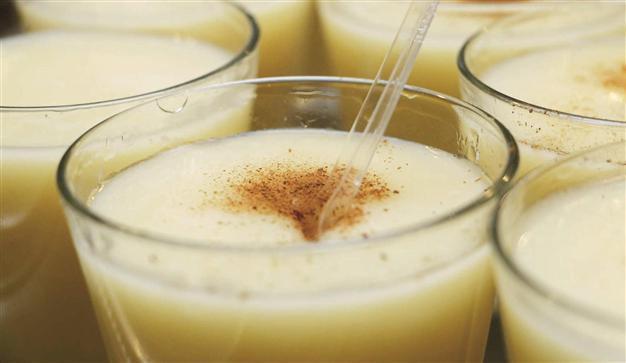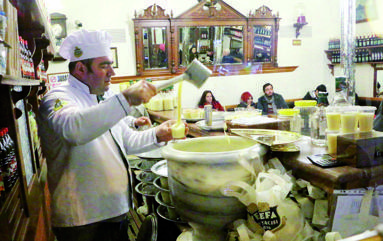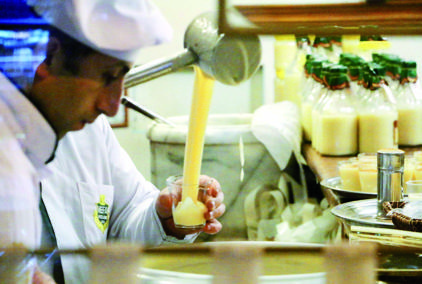The Ottomans’ favorite winter drink - boza
NIKI GAMM
 The cry “Boza” stridently rings out on the streets of Istanbul during the evenings at this time of year. It is a drink with origins extending far back in the Middle and Far East. Boza is a concoction made from millet or other grains that, it is claimed, dates back eight or nine thousand years in the Mesopotamian area. Archaeologists have discovered clay pots that held boza buried in the ground dating back to around 400 BC, the time of the Greek historian/soldier Xenophon. Others suggest that the Tatars of Central Asia introduced boza, although the word itself is derived from the Persian, “buuze darı.” Other terms were “bekni” in the Seljuk period, “buhoun” among the Karamanids (an Anatolian beylik that flourished from the 13th to the 15th century), and “mizr” among the Arabs.
The cry “Boza” stridently rings out on the streets of Istanbul during the evenings at this time of year. It is a drink with origins extending far back in the Middle and Far East. Boza is a concoction made from millet or other grains that, it is claimed, dates back eight or nine thousand years in the Mesopotamian area. Archaeologists have discovered clay pots that held boza buried in the ground dating back to around 400 BC, the time of the Greek historian/soldier Xenophon. Others suggest that the Tatars of Central Asia introduced boza, although the word itself is derived from the Persian, “buuze darı.” Other terms were “bekni” in the Seljuk period, “buhoun” among the Karamanids (an Anatolian beylik that flourished from the 13th to the 15th century), and “mizr” among the Arabs.The Kipchaks are supposed to have brought boza to the Balkans in the 11th century from Central Asia. Another version attributes the introduction of boza to Sarı Saltuk who was a 13th century derviş from Khorasan in today’s Iran. Several legends arose around him, including that he was a Christian monk; however, the Bektaşı dervişes adopted him as one of their own and he is identified with numerous places in the Bulgaria-Romania area.
Boza was popular throughout the Balkans, Anatolia and Africa during the Middle Ages and later. Numerous travelers such as Evliya Çelebi, Giosaphat Barbaro of Venice, F. S. Efromov of Russia and the German C. Neibuhr mentioned it in their accounts written at various times over the centuries.
 Boza and the Ottomans
Boza and the OttomansWhile boza can actually be made at home, the Ottomans allowed it to be sold on the streets even though it could contain a small amount of alcohol - as a result of allowing the fermentation period to be extended. Because of its contents, the Armenians and Rums (Turks of Greek origin) were permitted to open bozahanes or shops for the sale of boza. The majority of such stores were run by Armenians, while Greeks seemed to prefer opening meyhanes or wine shops.
The 17th century Ottoman traveler Evliya Çelebi noted that there were some 300 stores and 1005 boza sellers in Istanbul at the time he wrote his great travelogue book. He called them the “esnaf-ı darı bozacian,” the latter word clearly being from the Armenian language. Although Evliya Çelebi stated that he had never drunk anything alcoholic in his life, he didn’t seem to think that fermented boza was dangerous if used in moderation. He even believed that the drink strengthened the body, improved blood flow, and increased milk production in women who had just given birth. Ebru Boyar and Kate Fleet in their book, “A Social History of Ottoman Istanbul,” cite a different example from Evliya Çelebi.
According to him, drinking boza to excess contributed to dropsy and gout and, as a result dogs, were scared of people with those illnesses because they had to get about with a stout stick or crutches. In any case, the effects of the alcohol – at levels ranging from one to six percent – were offset by an addition to the drink pekmez and sprinkles of cinnamon, clove, ginger and nutmeg.
Boza and the bozahanes had their ups and downs depending on how religious the sultan of the time was or wanted to appear to be. Fatih Sultan Mehmed is thought to have loved boza, perhaps because of its invigorating qualities. The first bozahanes opened in the reign of Sultan Suleyman the Magnificent, and a law was laid down regulating them and charging for licenses. Boza was even served to members of the Janissary corps to strengthen them.
But when Sultan Selim II took the throne, the alcoholic contents in boza had reached four to nine percent so he put limits on it. The boza known as Tatar boza was completely forbidden, as opium was put in it.
 Sultan Mehmed IV in 1670 forbade the sale of liquor and boza but spent most of his time living in Edirne where he enjoyed hunting. While he was away, the meyhanes and bozahanes opened again without permission. Although the grand vizier, Merzifonlu Kara Murat Paşa (1676-1683) learned about it, he did nothing. When the sultan found out he wanted to get to the bottom of it and have the culprit executed, so the grand vizier blamed the kethüdası (chamberlain) Hasan Ağa and had the latter strangled before the sultan could investigate the matter.
Sultan Mehmed IV in 1670 forbade the sale of liquor and boza but spent most of his time living in Edirne where he enjoyed hunting. While he was away, the meyhanes and bozahanes opened again without permission. Although the grand vizier, Merzifonlu Kara Murat Paşa (1676-1683) learned about it, he did nothing. When the sultan found out he wanted to get to the bottom of it and have the culprit executed, so the grand vizier blamed the kethüdası (chamberlain) Hasan Ağa and had the latter strangled before the sultan could investigate the matter.In the 18th century, the bozahanes were opened but they were forced to keep the alcoholic content low. In order to keep their customers, they would sell liquor secretly. Despite the occasional prohibition, they began to resemble meyhanes, where people were expected to eat in addition to drinking alcoholic boza.
Boza, of course, can be made without the fermentation process. And while the Armenians generally produced a sour type of boza (keyf bozası), the Albanians began to manufacture a sweet boza (tatlı boza) without alcohol. This later type was much preferred in the imperial palaces.
The drink was popular outside of Istanbul; actually it was drunk in most places around the Ottoman Empire. In Samsun, on the Black Sea coast, there were many boza and şerbet sellers and meyhanes run by Armenians and Greeks until 1922-23. Turks began to open their own boza and şerbet places in other areas of the town. They sold keyf bozası but made two kinds – one keyf bozası and the other tatlı boza - having learned the latter learned from the Albanians. The keyf bozası sellers had more customers.
Sometimes the people would purchase keyf bozası to take home, where they would add flour and sugar to give it a different taste. At some bakeries they would make a special kind of boza and keep it there where it was warm. When they brought fish (sazan balık, or carp in English) they would have it baked and then take the boza and fish to the bozahane as if they were going to a meyhane. In 1923 after the Rums left, some of the meyhanes and bozahanes closed, but rakı generally took bozas place.
The story of boza would not be complete with a mention of Vefa Bozacısı, an Albanian family run store near Süleymaniye Mosque in Istanbul that was opened in 1876. Its main store is still in the original wooden building where the founding father began his trade. One of the most important changes he made was to ditch the wooden containers in which boza was being made and to replace them with marble. The classic drink is topped off with froth, cinnamon and leblebis (dried chickpeas).
















